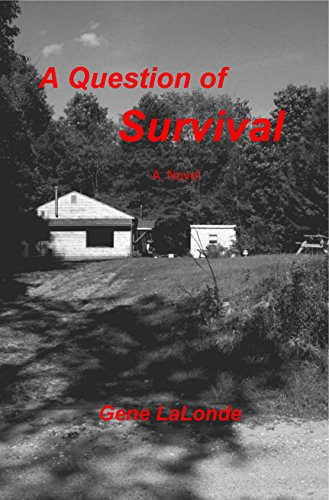
Author Gene LaLonde is a survivalist from upstate New York and it would appear as though Dave and Becky, the two main characters in his book, A Question of Survival, are very much based on himself and his wife. (The latter is acknowledged and thanked for having proofread this self-published novel.) Set in rural Vermont, LaLonde tells the story of a small handful of neighbours who through a strong work ethic, cleverness and survivalist knowledge focus on not merely surviving a catastrophic event, an electromagnetic pulse (EMP), but even thriving, as much as possible. In this apocalyptic EMP scenario, nearly all electronic devices and equipment, including telecommunications and vehicles, are destroyed from one moment to the next. Urban centres descend rapidly into a state of chaos and government agencies, like FEMA and the Department of Homeland Security, face anarchy and “rebel” groups.
David and Becky, as well as two sets of neighbours, decide to build their own life in the backwoods of Vermont, relying on nobody but themselves to get by. They garden, hunt, can vegetables and meat, and keep watch over their properties as the risk of desperate people or criminal elements looking to pillage and even kill pose a constant threat.
For someone interested in an introduction to survivalist practices, LaLonde’s book can be quite educational. At times, the novel reads more like a technical guide than a work of fiction. While the plot flows fairly well and is coherent, character development is where the book is lacking. There’s lots of interaction between Dave and Becky and their friends and neighbours, Ron and Mary, as well as with a young family that moves in next door later in the book. But with the possible exception of Dave, I struggled to really detect differences in voice and perspective among these characters.
Also problematic, at least for this Canadian reader, were strident political statements and conspiracy theories that kept appearing in the novel. The U.S. president, though unnamed, was repeatedly referred to as either “the traitor-in-chief” or “dictator-in-chief” by not only Dave, but at least on one occasion by the narrator as well. The narrator and Dave seemed to be on exactly the same wavelength. They were both staunch defenders of the 2nd Amendment, supporters of the NRA (there is a reference to an NRA mug in the story and much talk of guns) and had a remarkably dark view of government–painting it as deeply sinister. It’s certainly not at all beyond the realm of possibility that a survivalist like Dave would hold such views. But if the novel is being narrated in the third person, I would expect a certain critical distance between the protagonist and the narrator. In this book, the two appear to be one and the same. The frequent and sometimes gratuitous political attacks against the “traitor-in-chief” president were a distraction from the flow of the narrative.
I picked up LaLonde’s novel from a small bookstore in Watertown, NY during a recent visit to New York’s North Country. The Reading Room at the Salmon Run Mall has a section featuring local authors and I was curious how LaLonde would tell a post-apocalyptic story in a manner that is educational. The author is clearly a passionate and insightful survivalist and he wants to share his knowledge. I appreciated the information he shared and that his book generally eschewed sensationalism. But I think that there would have been a lot of potential to truly develop the characters and the little pioneering community that he created.
Rating: 3/5
Be First to Comment